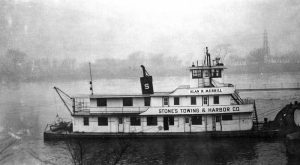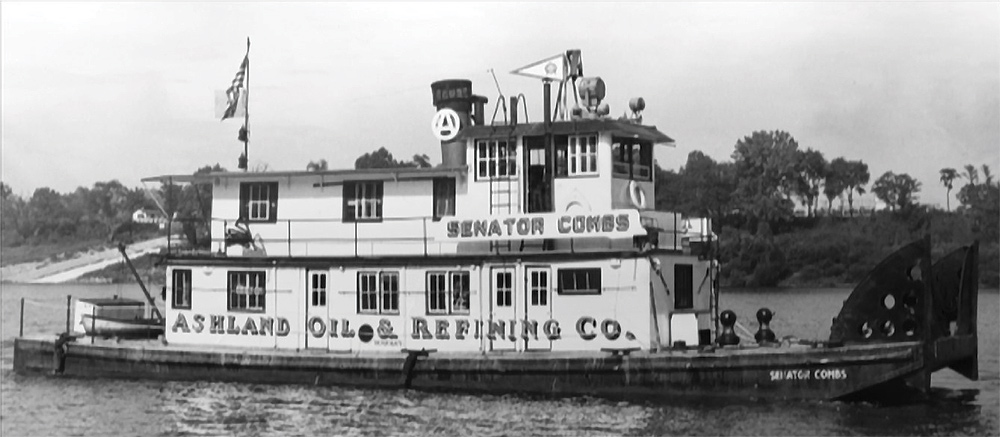In December 1923, the Swiss Oil Company, primarily involved in oil exploration and gathering, hired a young Paul G. Blazer and tasked him with selecting a refinery to purchase.
Blazer had already determined that the refinery would have to have access to river transportation. The deal on his first choice, a facility on the Licking River at Latonia, Ky., fell through, but on January 26, 1924, Swiss purchased a refinery from the Great Eastern Refining Company located at Leach, Ky., an obscure railroad stop 3 miles up the Big Sandy River from Catlettsburg. The small plant was placed under a concern called the Ashland Refining Company, with Blazer as the general manager.
A small diesel sternwheel towboat named Colonel and one barge had been included in the purchase, and a short time later a slightly larger sternwheeler named Scout was acquired. As business improved, Ashland Refining purchased yet another diesel sternwheel boat named Ruth-Ann, which delivered gasoline directly to service stations along the Ohio River as far downstream as Maysville, Ky. None of these boats were over 100 hp.
In 1935, Ashland Refining Company had progressed to the point that it ordered a new prop-driven diesel towboat from the St. Louis Shipbuilding & Steel Company and a new tank barge from the Marietta Manufacturing Company at Point Pleasant, W.Va.
The Waterways Journal was faithful in reporting progress on the new boat and in the January 18, 1936, issue the St. Louis Items column said that “The St. Louis Shipbuilding & Steel Company, Tuesday afternoon launched a 76-foot twin-screw Kahlenberg Diesel towboat built for the Ashland Refining Company, of Ashland, Ky.” The issue of January 25 carried a detailed description of the boat. There was a full-page ad on page 12 placed by the Kahlenberg Bros. Company, which supplied the main engines, as well as a full-page ad for the St. Louis Shipbuilding & Steel Company on page 13.
This was a bellwether event for St. Louis Ship as well as Ashland, with this being one of the most significant vessels for both since entering business. The boat was named Senator Combs, honoring Thomas Combs, who had been head of Swiss Oil until his death in April 1935.
The description of the boat termed it a “sturdy, powerful craft,” with a hull 76 by 20 by 6 feet, 6 inches, and of all-steel construction. The engines were twin Kahlenberg diesels, direct-reversing, rated 150 hp. each at 340 rpm. The propellers were 50 inches in diameter with 40 inches pitch. There were two steering rudders and four flanking rudders. The Combs was fitted with an air steering system from the S.J. Gardner firm of New Albany, Ind., controlled by steering levers, yet was also fitted with a pilotwheel for backup. The article noted that the Senator Combs would depart St. Louis for Ashland, Ky., as soon as ice conditions would permit.
The St. Louis news column of the February 29, 1936, issue of the WJ described a large run-out of ice and said that “Herman T. Pott, president (of St. Louis Shipbuilding & Steel), was up all night Monday night keeping an eye on the run of ice that began at 1 a.m. … No harm was done any of the barges or the new Diesel towboat Senator Combs.” The Waterways Journal of March 7 indicated that the Combs had departed the week prior under command of Capt. Charles R. Hutchinson.
Subsequent issues of the WJ reported that the new boat had passed Paducah, Louisville and Cincinnati, and that a group of individuals had boarded it at Portsmouth, Ohio, to ride in to Ashland, Ky. The boat was opened to invited guests at Ashland and then departed to Point Pleasant to pick up the new barge built there. About the time the Senator Combs entered service, the “child swallowed the parent” and Swiss Oil was merged into Ashland to become the Ashland Oil & Refining Company with Paul Blazer at the helm. The company would continue to grow, and with focus on river transportation the fleet would continue to expand with more barges and new diesel boats; a 1000 hp. in 1939, and a series of three identical 1,600 hp. boats in 1941 and 1942.
The late Robert E. “Bob” Kennedy, an early river mentor to this writer, worked on the Combs as a deckhand and mate and always called it “a little doll house.”
Practically speaking, the company outgrew the little boat, and in 1949 it was sold to Stone’s Towing & Harbor Company, Point Pleasant, W.Va. Reporting the sale to the board of directors, Blazer wrote, “It is with considerable regret, that I report the sale.” Stone’s, made up of Capt. Charles C. Stone and his son, Capt. Charles Henry Stone, had the boat extensively rebuilt by the Marietta Manufacturing Company. A 16-foot section was added to the middle of the vessel, the pilothouse was placed on the roof and the second cabin extended forward. The original engines were replaced by a pair of Fairbanks-Morse model 31A 6 1/4 diesels totaling 600 hp. The original single stack was retained but was later replaced with twin smokestacks.

Now measuring 92 by 20 feet, the boat was renamed Alan R. Merrill for a grandson of Capt. C.C. Stone. Marietta Manufacturing for several years ran large ads in the WJ featuring the rebuild.
The Merrill worked predominantly in the Kanawha River and near-Ohio River trades, and many area rivermen got their start on or worked on the Merrill over the years. One is Capt. Steve Pearson, who has told of steering the boat as a child while standing on a wooden soft drink case when his father, Capt. Landis Pearson worked on it. In 1966 the boat was sold to the R.E.&E. Corporation, Point Pleasant, one of Capt. Robert H. Bosworth’s concerns. In 1968 the Bosworth interests were sold to M/G Transport Services, Cincinnati. In June 1972 the Merrill was sold to G&C Towing, Point Pleasant, another company that had been started by Capt. Bosworth. In 1976 Capt. Bosworth had the Merrill on a lease/purchase to B&R River Transportation, also of Point Pleasant, and the boat was upbound on the Kanawha at Charleston, W.Va. when it caught fire. In the process of fighting the fire, the boat was swamped and sank, rolling over on its side.
The Merrill was raised and sold to someone on the Muskingum River, who had the pilothouse removed so that the boat could clear some low bridges, and Capt. Nelson Jones later acquired the pilothouse. Some years ago, an odd-looking boat was seen at one of the sternwheel festivals at Marietta, Ohio with the name Senator Combs on the stern. An online search found a Coast Guard news release from December 2004 about a recreational vessel named Senator Combs sinking at Zanesville, Ohio, on the Muskingum.
If anyone knows what finally became of the boat, I would love to know. It was the seed that grew what would become a premier oil fleet of the 1950s.




